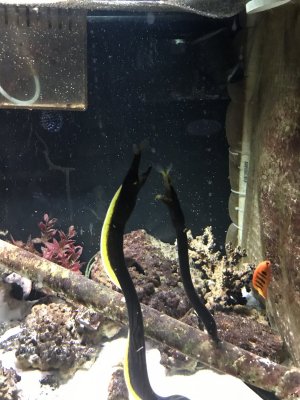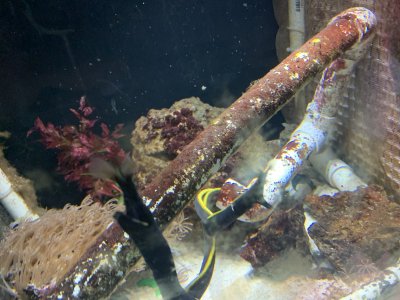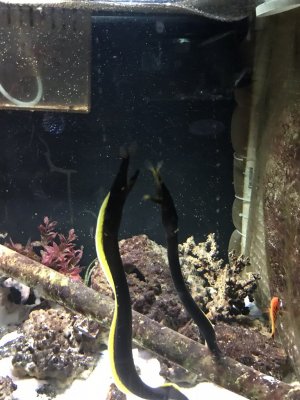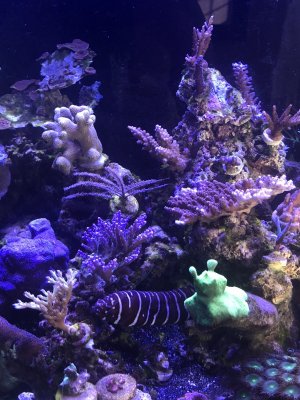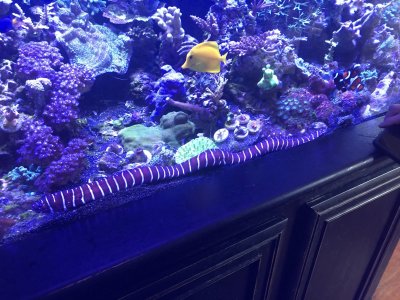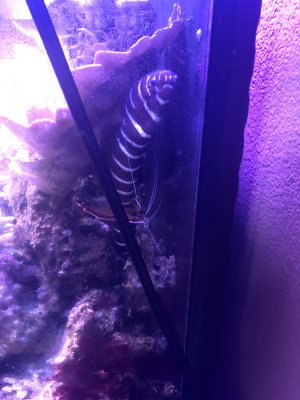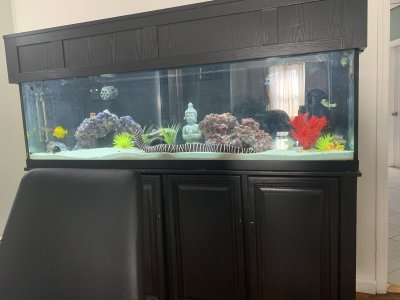Navigation
Install the app
How to install the app on iOS
Follow along with the video below to see how to install our site as a web app on your home screen.
Note: This feature may not be available in some browsers.
More options
You are using an out of date browser. It may not display this or other websites correctly.
You should upgrade or use an alternative browser.
You should upgrade or use an alternative browser.
Eel care guide!
- Thread starter tyler1503
- Start date
- Tagged users None
- Joined
- Dec 27, 2019
- Messages
- 85
- Reaction score
- 32
Wow I actually love that tank, I like the skulls, it looks very realistic like the edge of a reef. Super cool!Just an update from today, the zebra is hiding though.
Good info!!! Had a few Eels in my tanks. Recently picked up a Japanese dragon Moray. Best creature i owned thus far.


- Joined
- Aug 21, 2018
- Messages
- 226
- Reaction score
- 57
Hi All,
I need some advice regarding my 8-inch Skeletor moray eel. Currently, he’s in my 40-gal QT and I’m hesitant about moving him to my new 90-gal. Reason for this, is that I’ve witnessed it kill a 4-inch Bella Goby that’s with it in QT and I’m pretty sure it ate my Pajama Cardinalfish and Juvenile Dragon Wrasse that’s also with the eel in QT. Presumably if I were to move Skeletor to the 90-gal, it would be sharing space with my flame wrasse pair and I have this overwhelming dread that Skeletor would kill or try to eat the wrasses, since it has a history of killing/eating its fishy tankmates. Are my fears justified?
I need some advice regarding my 8-inch Skeletor moray eel. Currently, he’s in my 40-gal QT and I’m hesitant about moving him to my new 90-gal. Reason for this, is that I’ve witnessed it kill a 4-inch Bella Goby that’s with it in QT and I’m pretty sure it ate my Pajama Cardinalfish and Juvenile Dragon Wrasse that’s also with the eel in QT. Presumably if I were to move Skeletor to the 90-gal, it would be sharing space with my flame wrasse pair and I have this overwhelming dread that Skeletor would kill or try to eat the wrasses, since it has a history of killing/eating its fishy tankmates. Are my fears justified?
- Joined
- Feb 27, 2018
- Messages
- 94
- Reaction score
- 137
How is it with fish? My eel seems fine with angels and damsels, ate the others. Now, they even get up in the face of the two aggressive ones.. Shake and dance. They leave them alone....Good info!!! Had a few Eels in my tanks. Recently picked up a Japanese dragon Moray. Best creature i owned thus far.

- Joined
- Feb 27, 2018
- Messages
- 94
- Reaction score
- 137
Firstly, is this a skeletor echidna sp( pebble tooth) or the Gymnothorax variety. You have to come to grasp that the eel will possible kill other fish. I'd feed him well before the move, keep him fed well twice a week and prey he leaves them alone. When they are full, they are not typically aggressive. Do you have photos. I almost got a skeletor Gymnothorax species, now regret it. Also, I started a purigen reactor and added hypersorb too, hopefully this helps the ammonia waste/ organics from my eels.Hi All,
I need some advice regarding my 8-inch Skeletor moray eel. Currently, he’s in my 40-gal QT and I’m hesitant about moving him to my new 90-gal. Reason for this, is that I’ve witnessed it kill a 4-inch Bella Goby that’s with it in QT and I’m pretty sure it ate my Pajama Cardinalfish and Juvenile Dragon Wrasse that’s also with the eel in QT. Presumably if I were to move Skeletor to the 90-gal, it would be sharing space with my flame wrasse pair and I have this overwhelming dread that Skeletor would kill or try to eat the wrasses, since it has a history of killing/eating its fishy tankmates. Are my fears justified?
- Joined
- Aug 21, 2018
- Messages
- 226
- Reaction score
- 57
Hi there, I believe it’s an Echidna species of Skeletor moray eel. The first pic is what it looks like on LA and the 2nd pic is of my own. It sounds like it’s a 50/50 gamble on whether Skeletor will eat its tankmates in the new 90-gal.Firstly, is this a skeletor echidna sp( pebble tooth) or the Gymnothorax variety. You have to come to grasp that the eel will possible kill other fish. I'd feed him well before the move, keep him fed well twice a week and prey he leaves them alone. When they are full, they are not typically aggressive. Do you have photos. I almost got a skeletor Gymnothorax species, now regret it. Also, I started a purigen reactor and added hypersorb too, hopefully this helps the ammonia waste/ organics from my eels.
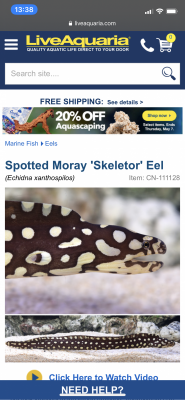
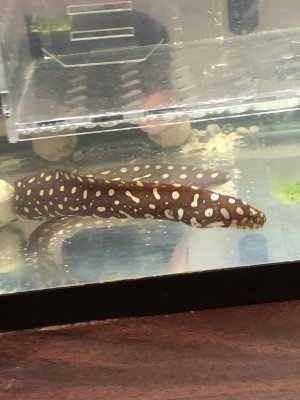
- Joined
- May 1, 2018
- Messages
- 152
- Reaction score
- 107
How would you quarantine a zebra eel? Anyone done it have any insights?
- Joined
- Jul 3, 2016
- Messages
- 6,797
- Reaction score
- 8,685
How would you quarantine a zebra eel? Anyone done it have any insights?
[/QUOTE
No copper, and eels are very resistant to protozan parasites like ick and velvet so concern over this is unnecessary. You may want to to prophylactically treat for internal parasites using general cure. Observation time and establishing a feeding routine before putting into the dt.
Nice set up great looking tank!!! Enjoy you Zebra Eel!!!!
Very nice write up, I’ve had a zebra eel for about 5 years now. He eats chunks of shrimp, I’d like to introduce to something more to have a variety, any suggestions the squid would be hard to find here.Eel care guide!
By Tyler1503
Now I'm far from an expert on eels, but having been in this hobby for a few years now and owning/looking after quite a few eels in my time, I feel I can confidently write this guide on basic care of these impressive little guys. I want to stress the point that everything I say is based purely on my experiences. It does not necessarily mean any eel you buy or look after will behave the same way. Your milage may vary. And for the record, I'm trying to keep this guide as universal as possible, but having a lot more experience with snowflakes than any other species, a lot of what I say will relate to them more than most others. I'm also writing this with the assumption the reader has the ability and knowledge to keep a successful tank running including the set up, cycling and acclimation phases. I, this article or any information contained within it will not be held responsible for any injury, damage or loss of life experienced.
---------------
I will start off with a bit of background of my time in the hobby, as well as some of the eels I've kept in the past.
I started in the fish keeping hobby with a goldfish named jerry in a small bowl lucky to hold a gallon. I loved jerry. I use to watch him swim about and wonder if he really had a three second memory or if that was a myth. Turns out mythbusters did it and they can remember things for atleast several weeks if I remember correctly. My first saltwater tank was a 5gal LPS and softy tank that is still running today. It's had it's fair share of ups and downs but it's a great little tank. I set up my 24 gallon fowlr, which is still running, a couple of years ago and loved the extra space! Currently it has a snowflake eel and a yellow tail blue devil in it. I've had several tanks in between all that, but nothing really worth noting here.
I'm currently setting up my first big tank. A 120 gallon fowlr. I was suprised by how different big tanks are compared to little tanks. So far I don't believe they're any easier as most say, but very different.
Now on to some of the eels I've owned. My first moray was a zebra. Awesome little guy! I got him while I was working at an LFS when a guy brought it back to the shop after it hitchhiked his way into the guys tank in some live rock. He was about as thick as a pencil and about 5 inches long. I took him home and loved him. Unfortunately one day we had a black out and he decided to swim into the intake of a pump. When the power came back on, he got shredded by the impeller.
The next eels I had were a pair of snowflakes that were kept at the LFS. I think the owner had a bit of a sentimental attachment to these guys because they were kept in a sump out of sight, not a display or selling tank and the owner wouldn't let me have one. I looked after them like as if they were mine, but couldn't take them home.
In the same LFS we had a big predator tank built into the counter top. Six foot long, three foot high and three foot wide. Inside we had a black ribbon eel amongst other fish. I was able to hand feed him and if I ever had my hand in the tank he would swim over and "sniff" me for lack of a better word. Since leaving the LFS that tank has been turned into a beautiful planted fresh water tank and I assume the eel was sold.
We also had a very big zebra in a display. He was as thick as my wrist! I could hand feed him and stroke his body and he seemed to enjoy it. But it's hard to tell the emotion of an animal that doesn't have any eyebrows haha.
I now own a snowflake eel, the one in the 24 I wrote about earlier. He'll be moved on to the 120 soon if all goes to plan.
I've also had some long in depth discussions with the owner of the local public aquarium about two large gymnothorax prasinus who reside there.
There's been other eels who have been in my care, but I won't go on for too long about each one. I think all these experiences with different species has given me a decent knowledge of morays and keeping them in captivity.
With that said, let's get on to something less about myself and more about our long slimy friends!
---------------
A (very) basic biology lesson!
Before choosing an eel, you should learn what exactly makes a moray a moray. Biologically they are quite different from other fish species for quite a few reasons.
To start with, they lack pectoral fins and pelvic fins. This means they can't swim the same way a normal fish does and must use their body to propel themselves through the water as opposed to their fins. This is the reason for their very muscular appearance.
The dorsal fin, caudal fin and anal fin are joined together from the back of the head along the entire length of the eel and around the underside of the body to the end of the tail.
They are long and slender which allows them to easily fit into small crevasses to find food, or to hide from potential predators. They are surprisingly quick considering the lack of pelvic and pectoral fins!
Morays cannot create the negative pressure in their mouths that some other fish do whilst eating. Ever see a Lionfish "inhale" some food? You'll never see a moray do that! It is believed this is because their head is too narrow. Instead, they use razor sharp teeth to capture prey and make use of a second pair of jaws located further down in the throat area. This extra set of jaws is called a pharyngeal jaw. It is used to carry food from the regular set of jaws located in the mouth, into the stomach. Morays are believed to be the only animal to use pharyngeal jaws to assist in capturing prey.
Morays are also quite intelligent. They will learn when, where and who is bringing them food and adapt to this feeding schedule. In the wild some species will actively hunt alongside certain grouper species. The eels will swim in and out of the reef face and chase fish out of their hidey holes. This allows the grouper to feed on the open swimming, unprotected fish that are scared out. The moray also will capture prey whilst doing this and can feed on the unprotected free swimming prey who re-enter the reef face after the grouper scares them back in.
A lot of morays have sharp pointed teeth and these species are generally fish eaters. Others, including the snowflake and zebra, have more rounded teeth that are used for crushing the shells of crustaceans, although some still eat fish and almost all morays eat cephalopods.
Morays have a tough, thick skin which secretes a thick slime coat. In captivity, this means they're much less likely to contract a lot of parasitic diseases and can take a slight bump from swimming into the rockwork.
The eyes of the moray are quite underdeveloped compared to most fish found in the marine aquarium hobby and their sense of smell is quite advanced. I'll get more in depth about this later as it is quite relevant at feeding time.
All snowflake eels start life as females. Once they reach sexual maturity they will either remain female, or turn into a male. The males generally have a slightly larger skull and have serrated teeth which the females do not.
As for zebra eels, they are born as either male or female but the female can change sex if need be to continue reproduction.
Ribbon eels all born as males and can change to female as they grow. They also change colour from black to yellow in females and black to blue as males.
Most eels will breed during any time of the year based on food supply and stored energy. The female will lay her eggs then release a hormone into the water column which attracts makes to the area who proceed to fertilise the eggs. The eggs hatch after 4-6 weeks and the young care for themselves as soon as they hatch.
There are at least 191 known species of moray ranging from 4 inches long, all the way up to nearly 10 feet long.
---------------
Choosing a moray!
Most species can be successfully kept in tanks slightly smaller than what is recommended, but to have them really thrive I would go a bit bigger than what most people say.
A smaller than recommended tank should only be attempted by people with a sound knowledge of reef keeping and eel care, as well as a decent knowledge of ambush predators and their general behaviour.
There are plenty of eels found in the hobby that, in the right environment, would be a perfect choice. But for the sake of this guide I will write a little on the three main species I am most familiar with.
Snowflake Eels - Echidna Nebulosa - A great eel for the beginner. Hardy, pretty and can live in less than perfect conditions (This doesn't mean you can slack off on tank husbandry though. They still need a well looked after tank!). They usually grow to about 1 1/2 - 2 foot long which means they can be kept with smaller fish. They can be slightly aggressive and chase fish around the tank and can eat a tankmate. Especially if you have bad feeding practices or you allow them to enter a feeding frenzy. I will get more into that a bit later though. In the wild they are generally a crustacean eater and usually cannot be kept with shrimp, crabs, lobsters or the like. I recommend a 75 gallon or bigger with most people suggesting a 55 gallon tank or bigger.

Snowflake eel.
Zebra eel - Gymnomuraena Zebra - Another great eel for the beginner for the same reasons as the snowflake, but generally need a cleaner tank to look it's best, so can be a bit more tricky than the snowflake. They can grow to about 4 foot long or more with a wide girth. They are known to be the most fish safe eel in the hobby and can usually be kept with smaller fish. In the wild they feed mainly on crustaceans meaning a CUC will quickly become lunch. They can become a bit cumbersome as they grow meaning all rockwork and corals should be very secure. I recommend a 180 gallon tank or bigger with most people suggesting a 120 gallon tank or bigger.

Zebra eel.
Ribbon eels - Rhinomuraena Quaesita - Not for the beginner. Even the most hardcore reefers can have trouble getting these guys to eat. I was lucky with the one I looked after as it was already eating prepared foods. If you've never had an eel or any difficult fish in the past don't even bother with these guys. It will most likely end with a dead eel and a bunch of cash down the drain. They look amazing, but are a fish I believe should not be sold to just anyone. They can grow to about 3 foot long. In the wild they eat fish and crustaceans and will eat just about anything that can fit in it's mouth. I won't even list a tank size or further information as if you are buying one, you should already have a sound knowledge of eels and how to look after them!

Black ribbon eel.

Blue ribbon eel.
---------------
Preparing the tank for a new moray!
So now you have your fully cycled tank, you can add an eel right? Not just yet! You need a place for your eel to hide first!
In the wild a typical moray will have at least three distinct dens usually a decent distant from each other. That way if there is very little food at one house, he just packs his things and moves into one of his other houses. I wish I had that kind of real estate! But what does this mean for the hobbiest? It means you need to provide atleast three (preferably more) places in your tank where your eel can call home. This doesn't mean one place with three entrances. It means three distinct places. A large bommie is a great one as this allows your eel the freedom to come and go, but also feel safe and enclosed while being able to watch everything that goes on in and around the tank. PVC piping under the sandbed and vertical along the tanks walls/corners is another great one that I personally recommend and more than two entrances/exits are recommended. So perhaps a "H" shape with the two side pieces at either end of the tank would be a good starting point as this allows four entries. Adding 45 or 90 degree elbow joins to the ends helps prevent sand from burying the entrances and blocking the eels path. You want the pipes to be longer than the eels body so she can lay in it without curling her body around a corner and thick enough so she can turn around, but thin enough so she feels safe.
Strong filtration is key to keeping morays. They are messy eaters and can put unnecessary stress on a tank if the filtration is not up to scratch. A large protein skimmer, good flow, regular water changes and regular tank maintenance is usually enough to keep your water levels acceptable. With all the extra food and waste being produced you may need to incorporate a nitrate and phosphate removing system to the tank like a refugium full of macro algae or a reactor of sorts. Some eels will refuse to eat if the water quality is not up to scratch and they can lose quite a bit of colour.
Eels are great escape artists and any small gap in the lid and she'll find it. They're more inclined to find holes in corners/along walls of tanks as they can "slither" up the walls like a snake. A strong and healthy snowflake eel can propel her entire body vertically out of the water up a smooth surface before falling back into the water or onto the floor. A strong eel can also remove lids from a tank if they are light enough. Keep this in mind when choosing the tank for your eel.
Eels are coral safe, but larger ones can knock down corals that aren't securely attached to the rockwork. Most are agile enough to get around without doing much damage though. They can be clumsy swimmers so realistically it's a chance, but out of all the eels I've owned in the past the only one who would knock corals down was the very large zebra.
Eels are typically nocturnal so you may not see your new eel much for the first few days or weeks, but she will come out and explore during the day eventually. Most eels are quite active for the first few weeks or months of being in a new environment, just like a puppy or kitten, they want to explore everywhere! Eventually they will settle down and not spend a great deal of time outside their chosen dens, that is, until feeding time.
How do you get her out of your acclimation bucket, QT, DT or wherever she may be? Because of their size, shape and tendency to jump out of nets, eels can be notoriously difficult to catch if you don't know a few little tricks. Place a piece of PVC into the tank and let her rest in it for a few hours so she's comfortable. Simply net each end of the pipe and remove it. You could even use a PVC cap on one end and only use one net on the other end. This is my personal favourite method as it's so easy and when done properly has a very good chance of working.
You could also take out the rock she likes to sleep in, although speed is of the essence with this method. You never know when she may jump out of her rock and land on the carpet! Plus it leaves your fingers open for biting. If she feels as though you are disturbing her den, she may snap.
So to reiterate this section, lots of hiding places, strong filtration and a secure fitted lid are all must haves!
Now onto every morays favourite topic.......
---------------
Food!
Before I get into what to feed your eel, I'll speak a little about how an eel will find it's food and the potential dangers associated with this.
Eels have a very advanced sense of smell which they use to sniff out potential meals. You may notice your eel is swimming about and occasionally shaking her head from side to side, almost violently. You don't need to worry as this is her trying to say "I'm hungry!" and she's trying to find food. She does this by following the scent she picks up when she shakes her head. The shaking helps her decide which direction she thinks the smell is coming from and she follows her nose.
Contrary to the popular belief that eels are blind, they do in fact have vision. They do not have very advanced vision, but none the less, it's there. My snowflake can see me from the other side of the room about 5 foot away and comes out of her den when she wants food.
This strong sense of smell and bad eyesight can potentially turn dangerous when trying to hand feed your eel. I don't hand feed my eels anymore as I have been accidentally bitten before and it's not pretty and takes a LONG time to stop bleeding. I do not condone or recommend this activity.
Being nocturnal predators, most eels will naturally want to hunt at night however most eels in captivity will adapt to eating during the day straight away. Some may need a bit of encouragement though which means you may have to attempt initial feedings of a nighttime until your eel is more comfortable.
Eels will also become quite habitual regarding where they get their food from. We as humans also become habitual regarding where we feed our fish. This is a great combination as it makes feeding them that little bit easier. For instance, if you feed all your fish from the left hand side of the tank, you could start feeding your eel from the right hand side. This keeps all other fish distracted and away from the eel and away from the eels food. This can help suppress the hunting instinct as the eel will learn it doesn't need other fish around in order to eat. She will learn that when her side of the tank opens up, food is here!
I usually feed my eels anywhere between 2-4 times a week. I try not to feed very little, then all of a sudden change it to a whole lot of food in one go. Like everything in this hobby, changes should be made slowly.
Don't stress if you miss a feeding or two, a lot of eels can go weeks or months without eating without experiencing any health issues. That doesn't mean you can starve your little girl, they still need regular feedings.
If fed purely on prepared foods they will learn that they're next meal is coming and in most cases that's enough to suppress that hunting instinct in a lot of species, particularly snowflakes as zebras.
She may also be more of a threat to tankmates if you feed live foods. She will learn that she has to go looking for food and has to kill in order to eat. If you feed her prepared foods she will learn that you will bring food to her and she won't have to hunt. A hungry moray that's used to hunting won't think twice about that cute little clownfish unless she knows you'll bring her a meal. However the hunting instinct may never fully go away and she may still chase tank mates a bit. My snowflake has been purely on prepared foods for quite a while now and still chases fish around the tank every so often. Once she realises that it's another fish she's chasing and not a potential meal she settles down quit a bit.
What type of food depends on what species of moray you have. Most will accept squid and shrimp without any hesitation and both of these foods are great staple diets. They're cheap, readily available and nutritious but there are many great packaged foods out there specifically designed for larger predators.
I go to the seafood counter at the supermarket and ask for three fresh squid rings (the type you would crumb to make calamari rings) or prawn cocktails (those raw shrimp with the head, shell and legs already removed, but the tail is still attached). My snowflake will eat two or three of these in a single meal depending on the size and how long it's been between feedings. Remember to wash the food really well before feeding it and remove any shells that may be left on the food. Tap water is good enough for cleaning the food.
I now use small plastic fork type things to feed my eel. I got them in the party section at the supermarket. I think they're designed to be used for eating cheese and olives and fancy stuff like that. It usually costs me about $0.25 a week to feed my eel.

My feeding fork. I buy packs of 250 for $3.
From my experience, I've found they (especially snowflakes) grow according to how much food they get. More food = more growth. Similar to a snake in that respect. So if you want a big strong eel to show off, feed, feed and feed some more! The eel will tell you when she has had enough to eat as she will return to her hideout.
If you limit feeding, they may not grow as big as they potentially could have meaning they're less likely to see smaller fish as a potential meal, but less feeding can lead to more aggression. It's all about finding that balance when it comes to feeding eels. This is no guarantee though, if your eel was supposed to be big, she'll still be big!
If you have an eel that is so stubborn that it will persistently chase fish around,you may have to consider rehoming the other fish or the eel.
I've found if something is up to the size of from the very front of the head to the back of the gill opening, it's likely to be eaten. Anything up to twice that size is likely to be chased and possibly bitten. Anything bigger is likely to be safe (unless your a shrimp or crab or the like. If you just so happen to be a shrimp or crab or something similar, be prepared to become dinner at almost any size).
Feeding frenzies are a very real risk with eels. This is when the eel has an almost uncontrollable need to feed. She will chase tankmates, maybe take bites at them and can cause quite a lot of trouble. Some eels will be quite well behaved even when in a frenzy, but others will be little terrors. It depends on the individual. If your eel enters a frenzy, keep your hands out of the tank at ALL times and be prepared to lose a fish. Chances are she will settle down and not harm anything, but it's still a very real possibility that something will be eaten.
Luckily frenzies are pretty easy to avoid. Stick to a feeding schedule and have all your food ready to feed before starting feeding your eel. If you choose the supermarket seafood route to feed your eel, make sure you cut all the seafood first. Don't cut a piece, feed it, cut another piece, feed it and so on.
As I mentioned earlier, stick to your feeding schedule and you shouldn't have issues with frenzies. Don't stress if you miss a day or two, but try not to let your eel go hungry. Any more than 3-4 days without food could set off a frenzy in some individuals while others will go weeks without food and not go crazy. Learn your eels personality and you will have a much easier time dealing with frenzies.
Let's say your eel does enter a frenzy. What do you do? Don't stick your hand in the tank! Use a feeding stick or feeding tongs to give your eel as much food as she wants. This is the best way to calm an eel. During a frenzy your eel may eat up to twice as much as she normally would so always be prepared to feed a little extra.
---------------
Temperament, aggression and tank mates!
Despite the bad reputation, aggressive appearance and leather jackets they so fondly wear, most eels are actually quite shy. They would rather run or hide than fight.
In fact, most moray eel attacks on humans are either caused by hand feedings gone wrong by mistaking fingers for food, disruption of the eels den or by provoking the eel. Not because she was simply hungry or in a bad mood.
In captivity an eel can quickly become confident and feel secure. You'll know this has definitely happened because she will be hiding a lot more, not out exploring her new home like she probably did when she was first introduced. This can take anywhere from a few days up to a few months.
Most medium and large fish are great tank mates for snowflakes as zebras, but quite a lot of other eel species need a tank for themselves.
Some potential tank mates may include: Tangs, wrasses, rabbit fish, triggers, puffers, lionfish, angels and larger clowns. There are plenty more, but from my experience these are some of the most common tank mates. Snowflakes and zebras can even be kept with each other with caution if they're are still young when added and added at the same time.
---------------
Diseases, treatments and risks associated with keeping eels!
Most morays are extremely hardy creatures. Most will overcome pretty much any disease it could contract in a marine tank and luckily it's a relatively easy process to help them do so!
Always QT a new arrival even if she looks to be in perfect health. You never know what might be carried in on your eel that may not affect her, but could decimate the rest of your fish population. Even in QT your eel will need a place to hide. Some PVC pipe is perfect for this, just like I wrote about earlier. Following a regular QT process is fine during this time, with the exception of medications. Most medications do not agree with eels and should not be used. Keep an eye out for any symptoms of disease and if after 6-8 weeks she still looks healthy, you can add her to the DT.
Signs of disease can include;
- fading colours.
- loss of appetite (if a dormant stage has been ruled out).
- swelling of the face or body.
- cuts or scrapes that change in colour, shape, size or texture or will not heal.
- weak swimming ability.
- acting lethargic and sluggish.
- cloudy eyes.
- strange and often discoloured patches of skin or bumps.
- unnatural coloured poop.
- swelling of the abdomen.
Most of these can be treated by placing the eel in QT with a good vitamin enriched diet, an antibiotic medication (if necessary. Check with your LFS or online vendors as to which medications they have available that are suitable for morays) and good water chemistry. In my experience eels can be sensitive to copper although I cannot confirm this 100% as I refuse to use copper to treat them after losing a snowflake to it.
I believe a good diet and good water chemistry is the best way to treat a sick eel, with hyposalinty (only used for white spot/ich (which is very rare for a moray to contract)) being next on the list of disease preventative actions. Actually, I believe a good diet and good water chemistry is the best way prevent having a sick eel in the first place.
While your eel could enter a frenzy, she could very well enter a dormant stage were she can refuse to eat all together. Before assuming it is a dormant stage you should check your tanks chemistry (including temperature and salinity), any obvious signs of stress and any signs of disease in her or in other livestock. Most of the time it is just a dormant stage which is a natural thing that most eels will experience at some point. They can go several months without eating if they choose. Don't panic if your eel does stop eating one day, keep trying to get her to feed a few more times over the next week and if she still refuses to eat, let her go hungry for another week and try again. As long as the eel is not losing body mass and her colour is still nice, your still in the good zone. If she starts looking skinny or showing signs of disease you may have to look into other causes to her not eating with a parameter (particularly nitrate) being out of wack being the most common cause. Check water chemistry again, look for signs of disease in your eel and other tank inhabitants and perform a water change (20-50% is recommended).
Most of the main risks of keeping eels have already been mentioned throughout this guide, but I'll repeat them here for the sake of keeping them all in one place.
- do not hand feed your eels. As fun and exciting as it may be, it could end with you missing a finger or two.
- eels are escape artists! They can squeeze through tiny little gaps that you would never expect them to find.
- never let a young child or person who is inexperienced with marine tanks feed the eel or put their hands in your tank. Again, fingers can go missing.
- always treat your eel with respect. Don't rough her up and tease her because she can't attack you through the glass. Not only is this cruel, but eels are smart enough to recognise you as the jerk who harassed her earlier.
- they are messy fish who can produce a lot of waste. Keep an eye on nitrate and phosphate, especially in a reef tank.
- always have fun with your eel. If you start to feel as though feeding her is becoming a chore and you would prefer to just chuck in a cube of mysis and let the other fish eat it themselves, it may be time to consider rehoming your eel. No one wants to be a nuisance to anyone else, even our fish. If your losing interest in her, pass her on to someone who will take the time to care for her properly. Don't let your eel go hungry or let your husbandry slip as this will only stress your eel and increase the risk of feeding frenzies and in turn, increase the danger to yourself.
---------------
My favourite eel story!
Over the course of a few weeks I trained my current snowflake to swim into a net to eat! I use to feed her food from the net and she eventually learnt the food was actually inside of it. She would poke her head right of the rock and inspect the net and eventually figured out she could enter the net and get food for herself. She's way too big to do this now, but as a baby it was good fun to watch. I removed her from the tank this way several times (I don't recommend this method of removing them from tanks though, as they can jump out of nets so easily). She seemed to enjoy being in a dark isolated net as she would eat the food and lay in there for a while before returning to her regular spot back in the rocks
---------------
So I've covered a bit of science, possible choices for your first eel, tank preparation, food, possible tank mates, disease and treatment and the risks and dangers of eel ownership an even shared my favourite eel related anecdote. Any questions? Comments? Concerns? Let me know below! Have I missed something important? Just tell me and I'll be happy add whatever extra information I can ASAP!
Also, recently I have been having issues with hair algae and it was suggested to me to use fluconazole. Do you have any idea how that might affect the eel? It says reef safe, fish safe and inverts. I’m just scared a little and don’t want my big guy getting sick or dying?
- Joined
- Jul 3, 2016
- Messages
- 6,797
- Reaction score
- 8,685
Very nice write up, I’ve had a zebra eel for about 5 years now. He eats chunks of shrimp, I’d like to introduce to something more to have a variety, any suggestions the squid would be hard to find here.
Also, recently I have been having issues with hair algae and it was suggested to me to use fluconazole. Do you have any idea how that might affect the eel? It says reef safe, fish safe and inverts. I’m just scared a little and don’t want my big guy getting sick or dying?
I honestly would not use any sort of algaeside with an eel, it is a chemical, really no different than round up for your lawn. My lion's reef was completely wiped out after using Vibrant, coincidence? Eels and lions have a similar reaction to many things.
Zebra's love live fiddler crabs, check out the fresh water section of your lfs. Lfs also carry squid as well as clams. Your frozen seafood section may also carry squid, labeled under calamari to make it more appealing. You may also find crabs and crawfish, just make sure they are raw
Does a snowflake eat cleaner and peppermint shrimp?
- Joined
- Jul 3, 2016
- Messages
- 6,797
- Reaction score
- 8,685
Does a snowflake eat cleaner and peppermint shrimp?
Yes, while some have established a somewhat coexistence with the cleaner, it is usually short lived. Peppermintd would be an excellent food option.
I was afraid of that indeed
Similar threads
- Replies
- 25
- Views
- 471
- Replies
- 14
- Views
- 218








